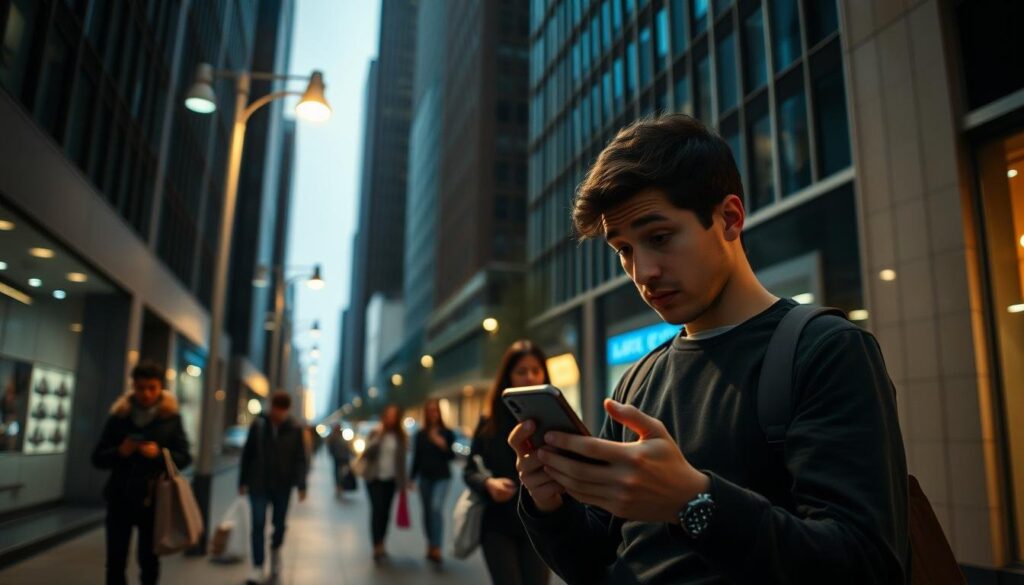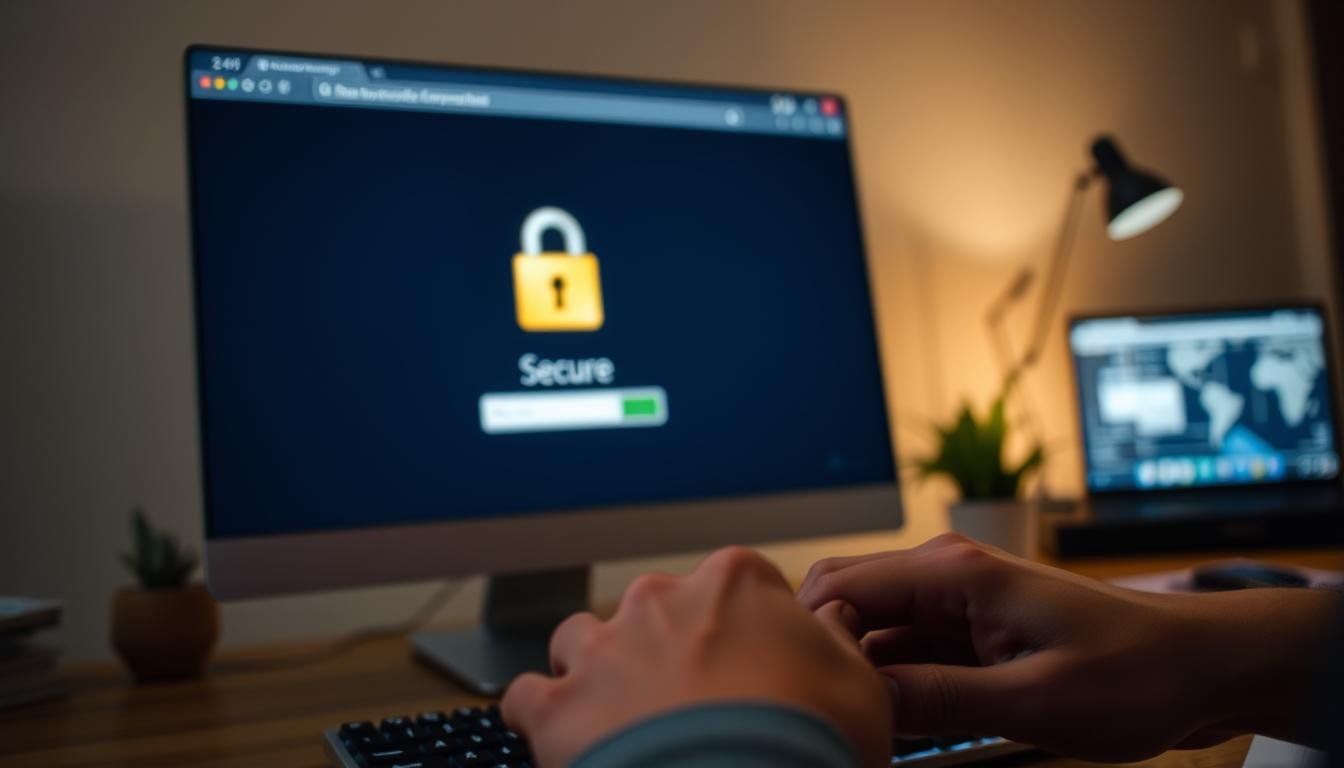Check Website Safety Before Providing Credit Card: When you shop online, keeping your credit card info safe is key. With more online deals, credit card security is a big worry. You must be careful when sharing your details online.
Checking if a website is safe is very important. A secure site protects your data, making online shopping safer. Knowing how to check a site’s security helps you shop online without worry.
It’s important to know the dangers of online shopping. Also, learning how to check if a site is secure is crucial.
Contents
- 1 Understanding the Risks of Online Shopping
- 2 Look for Secure Connection Indicators
- 3 Verify the Website’s Legitimacy
- 4 How to Check if a Website is Safe Before Entering Credit Card Info
- 5 Leverage Browser Security Features
- 6 Mobile Shopping Safety Considerations
- 7 Secure Payment Options to Consider
- 8 Conclusion: Check Website Safety Before Providing Credit Card
- 9 FAQ
- 9.1 What are the signs of a secure website?
- 9.2 How can I verify a website’s legitimacy?
- 9.3 What tools can I use to check if a website is safe?
- 9.4 How can I enhance my online security while shopping?
- 9.5 Is it safe to use public Wi-Fi for mobile shopping?
- 9.6 What are some secure payment options I can use?
Understanding the Risks of Online Shopping
Online shopping is convenient but comes with risks. You could face financial fraud. Cybercriminals keep finding new ways to trick shoppers.
Some of the risks include:
- Unauthorized transactions
- Identity theft
- Phishing scams
Statistics on Financial Fraud in the US
Financial fraud is a big problem in the US. Here are some recent numbers:
- The Federal Trade Commission (FTC) got over 4.7 million fraud complaints in 2022.
- Credit card fraud was a big part of these complaints.
Knowing about these risks and numbers helps you shop online safely. It’s key to be careful and informed to keep your financial info safe.
Look for Secure Connection Indicators
To keep your online transactions safe, it’s key to spot secure connection signs. Always check for these when shopping online to protect your data.
Secure connection signs show a website is encrypting data between your browser and itself. Look for “https” in the URL and a lock icon in the address bar.
Browser Security Icons and What They Mean
Browser security icons give you a quick look at a website’s safety. Here’s what each icon usually means:
| Icon | Status | Description |
|---|---|---|
| Lock Icon | Secure | The website has a secure connection (https). |
| Warning Sign | Insecure | The website has an insecure connection (http) or mixed content. |
| Neutral Icon | Not Fully Secure | The website may have some secure elements but not fully secure. |
Always look for the lock icon and “https” to ensure you’re on a secure site.
By knowing and spotting these secure signs, you can lower the risk of data loss during online shopping.
Verify the Website’s Legitimacy
Checking if a website is real is key to staying safe online. When you shop online, you want to know you’re buying from a trusted site. Look for a physical address, contact details, and reviews from other customers.
A real website will have a real address, not just a PO box. They should also have a clear contact page with a phone number, email, and maybe a contact form. You can test if the contact info works by calling or emailing them.
Customer reviews can also help you see if a website is legit. Check out reviews on the website, Google, and social media. Be wary of reviews that seem too good to be true or sound the same.
| Legitimacy Indicator | Description | Red Flag |
|---|---|---|
| Physical Address | A legitimate business will have a physical address listed. | PO box only |
| Contact Information | Valid phone number and email address. | No contact info or unresponsive |
| Customer Reviews | Reviews on multiple platforms, not just the website. | Overly positive or fake-sounding reviews |
By checking these signs, you can decide if a website is safe to use. This helps you feel sure when you give out your credit card info.
How to Check if a Website is Safe Before Entering Credit Card Info
It’s crucial to check if a website is safe before you enter your credit card details. Online shopping has grown a lot, making it key to check if websites are legit and secure.
Several tools and services can help you see if a website is safe. Google Safe Browsing and McAfee WebAdvisor are two top choices.
Google Safe Browsing and McAfee WebAdvisor
Google Safe Browsing checks websites against Google’s lists of unsafe sites. You can check a site’s safety by visiting Google Safe Browsing and typing in the URL.
McAfee WebAdvisor offers real-time safety checks and ratings for websites. It warns you if a site is harmful or has unsafe content.
| Tool | Description | How to Use |
|---|---|---|
| Google Safe Browsing | Checks websites against lists of unsafe web resources | Visit the Google Safe Browsing site and enter the URL |
| McAfee WebAdvisor | Provides real-time protection and safety ratings | Install the McAfee WebAdvisor extension and it will automatically rate websites |
Using these tools can greatly improve your online safety. It helps protect your credit card info from threats.
In summary, checking a website’s safety with tools like Google Safe Browsing and McAfee WebAdvisor is a smart move. It’s a simple way to keep your online transactions safe.
Leverage Browser Security Features
As you explore the digital world, using your browser’s security features is key. Modern browsers have advanced tools to keep you safe from online dangers.
Enhancing your browser’s security starts with knowing its built-in tools. These tools warn you about dangerous sites, protect against bad downloads, and keep your data safe with encryption.
Browser Extensions for Enhanced Security
Browser extensions can add more protection too. You can find extensions that block harmful content, warn you of threats, and even hide trackers for better privacy.
When picking extensions, choose ones from trusted sources. Look for extensions with positive reviews and know what they do. Using your browser’s security features with the right extensions can greatly boost your online safety.
Mobile Shopping Safety Considerations
Mobile shopping is getting more popular, but it comes with safety risks. When you shop on your phone, you share your credit card info with the world. This can be a big problem.
Public Wi-Fi networks are a major concern. They’re not secure, making it easy for hackers to get your data. To stay safe, use a Virtual Private Network (VPN) to hide your internet traffic.
Using VPNs for Secure Transactions
A VPN makes a safe tunnel between your device and the internet. It keeps your data safe from hackers. Choose a VPN that’s well-known and has strong security.
Here are more tips for safe mobile shopping:
- Use a secure browser with anti-phishing protection.
- Keep your operating system and apps up to date.
- Be cautious when using public Wi-Fi networks.
- Use two-factor authentication whenever possible.

By following these steps and using a VPN, you can make your mobile shopping safer. This way, you can protect your credit card info.
Secure Payment Options to Consider
Choosing the right payment options is key to protecting your credit card info when shopping online. PayPal is a top choice because it acts as a middleman between your card and the seller. This adds an extra layer of security.
Using credit cards with strong credit card security features is also a good idea. Look for cards with fraud protection and zero-liability policies. These features mean you won’t be blamed for unauthorized transactions.
Consider using virtual credit cards or single-use card numbers for online buys. Many banks offer these. They create a new card number for each purchase, reducing your risk.
Using these secure payment options makes online shopping safer. It helps protect your financial information and ensures a secure transaction.
Conclusion: Check Website Safety Before Providing Credit Card
When you shop online, keeping your personal and financial info safe is key. Knowing the dangers of online shopping helps a lot. Also, checking if a website is real can really help avoid cybercrime.
To shop safely online, look for signs of a secure connection. Use your browser’s security tools and choose safe payment methods. These steps help you enjoy online shopping without worrying about your safety.
Being careful and informed is essential for safe online shopping. By following the advice in this article, you can shop confidently. You’ll know you’re doing everything you can to protect yourself online.
See Also: Is a Co-Branded Airline Credit Card Worth It in 2025?
FAQ
What are the signs of a secure website?
A secure website has “https” in the URL and a lock icon in the address bar. This shows the connection is encrypted and safe.
How can I verify a website’s legitimacy?
Check for a physical address, contact information, and customer reviews. This helps ensure you’re dealing with a trustworthy business.
What tools can I use to check if a website is safe?
Use services like Google Safe Browsing and McAfee WebAdvisor. They help verify a site’s safety and protect your credit card info.
How can I enhance my online security while shopping?
Use browser security features like extensions. They block malicious content and alert you to threats, adding protection.
Is it safe to use public Wi-Fi for mobile shopping?
No, public Wi-Fi is not safe for mobile shopping. It’s open to hacking. Use a VPN to secure your transactions.
What are some secure payment options I can use?
Consider PayPal or credit cards with strong fraud protection. They help keep your financial info safe.

